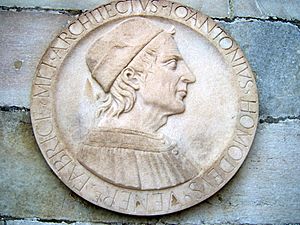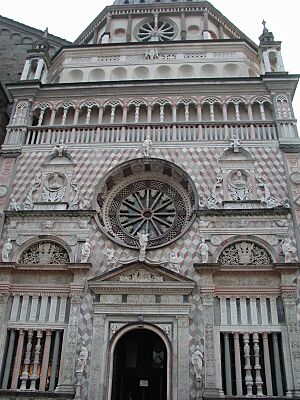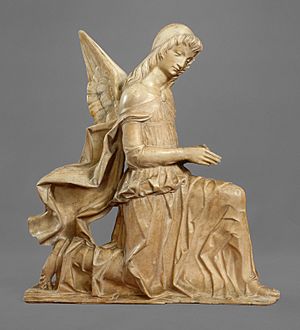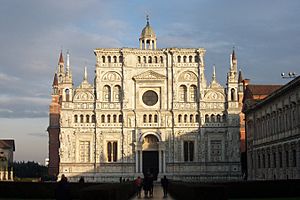Giovanni Antonio Amadeo facts for kids
Giovanni Antonio Amadeo (born around 1447 – died August 27 or 28, 1522) was a talented Italian Renaissance sculptor, architect, and engineer. He lived during the Early Renaissance period in Italy, a time when art and learning flourished. Amadeo is known for his beautiful sculptures and important buildings across Italy.
Contents
Early Life and First Big Projects
Giovanni Antonio Amadeo was born in a city called Pavia. One of his first major projects began in 1470. A powerful leader named Bartolomeo Colleoni hired him. Amadeo's job was to finish Colleoni's special burial chapel, the Cappella Colleoni, in Bergamo. Other artists had started it, but Amadeo added many beautiful details.
He decorated the chapel with colorful designs and many sculptures. These included round medallions, small columns, and busts (sculptures of heads and shoulders). He also created carvings showing stories from the Old Testament and the tales of Hercules. Amadeo also designed a tomb for Medea Colleoni, Bartolomeo's daughter. This tomb was meant for a church in Urgnano. He worked with other artists on this tomb, creating carvings for the sarcophagus (stone coffin) and statues of virtues.
Working for Dukes and Monasteries
Amadeo also worked for Duke Galeazzo Maria Sforza at the Certosa di Pavia, a famous monastery. Between 1473 and 1476, he created many detailed carvings for the right side of the monastery's front.
In 1480, he finished a special arch for the Persian Martyrs at a monastery in Cremona. Four marble carvings from this arch still exist today. People also believe he made two statues representing Justice and Temperance in Cremona. Some of his carvings are also found in a museum in Parma. In 1485, he worked with his brother-in-law, Pietro Antonio Solari, on the Ospedale Maggiore in Milan. This was a large hospital project, and Amadeo became its director ten years later.
Major Works in Milan and Pavia
Amadeo played a big role in decorating the famous Milan Cathedral. He worked on its central dome and the lantern (the small tower on top). He also teamed up with another famous architect, Donato Bramante, on the front of the Santa Maria presso San Satiro church in Milan.
In 1488, a cardinal named Ascanio Sforza chose Amadeo to lead the building of the new Pavia Cathedral. Bramante also had a smaller role in this project. In 1489, Amadeo helped design and build the Arca di San Lanfranco for a church in Pavia.
During this time, he also worked as an engineer for Duke Ludovico il Moro. He designed strong defenses for towns like Chiavenna and Piattamale. He also fixed roads and bridges in the Valtellina area. Later, in the 1500s, he worked on water systems. For Duke Ludovico, he also built a beautiful loggia (an open gallery) in the Ducal Palace of Vigevano. He also made some statues for the Milan Cathedral.
From 1495, Amadeo was in charge of building the church of Santa Maria presso San Celso in Milan.
From 1497, he directed the work at the Milan Cathedral again, finishing the tambour (the circular base of the dome) in 1500.
Later Projects and Legacy
In the 1500s, Amadeo designed the church of Santa Maria di Canepanova in Pavia. In 1501, he sculpted carvings showing "Stories of the Carthusians" and the "life of St. Bruno" for the Certosa of Pavia.
For many years, people thought the Sanctuary of Chiesa di Santa Maria alla Fontana in Milan was designed by Leonardo da Vinci. But in 1982, it was proven that Amadeo was actually the designer! In 1508, he also created a model for the spire of the Milan Cathedral, but his design was not chosen.
The impressive front of the Cathedral of Lugano is also thought to be one of Amadeo's masterpieces.
Giovanni Antonio Amadeo passed away in Milan in 1522. His work left a lasting mark on Italian Renaissance art and architecture.
See also
 In Spanish: Giovanni Antonio Amadeo para niños
In Spanish: Giovanni Antonio Amadeo para niños





